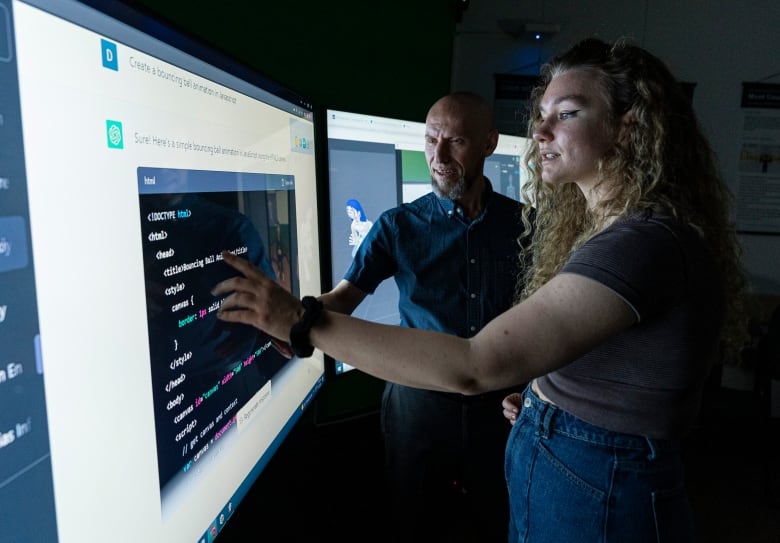
Sharanya Sivasathiyanathan is well-versed in generative AI.
The Grade 12 student might tap DALL-E to create a visual of the sci-fi world she’s dreamt up for a writing competition, for instance. Or, if she gets stumped by a new math concept, the Ottawa teen might ask ChatGPT for a more precise explanation to her specific questions.
Still, she keeps artificial intelligence apps largely to her spare time — “extracurricular activities as opposed to in the classroom, just because there’s still some ambiguity whether it’s allowed or not allowed in the classroom,” she said.
Widespread use of Gen AI in schools has been held back by myriad concerns. Does using an AI app constitute cheating? Does it foster over-reliance on technology? How do we address apps spitting out incorrect, inappropriate or biased results? And will using these apps put students’ personal information at risk?
While young Canadians are diving into Gen AI — for brainstorming and research as well as to create art and draft resumés — education ministries and school boards have been uneven in issuing official policies about how to use it. Students and experts alike say this inconsistency hinders both learners and educators trying to navigate today’s AI-influenced reality.
Various stakeholders — from professional networks to unions to school board associations — have dipped into these questions in the past six months, with a couple of provinces issuing guidelines.
This summer, British Columbia’s Ministry of Education and Child Care updated a guidance document for school leaders, teachers and families. It emphasizes ethical and responsible integration, with careful consideration of factors like equitable and inclusive access, data security and privacy, enhancement of student learning, ongoing evaluation and transparent communication with families.
After organizing a conference on the issue last spring, New Brunswick’s Department of Education and Early Child Development released recommended approaches for integrating Gen AI. It has specific directions for administrators, teachers and students, respectively, with ethical considerations, academic integrity, responsible use, data privacy and ongoing assessment among the topics addressed.
Overall, however, “provinces and territories are moving a little bit too slowly on developing guidance for teachers …We’re in desperate need of clear and concise guidance,” said Sarah Elaine Eaton, a professor at the University of Calgary’s Werklund School of Education, whose research topics include academic ethics and AI.
“I’d like to see more clarity and also clear direction for classroom teachers about how to integrate these apps ethically, and when to hold back.”
The Morning Edition – K-W11:52Waterloo Catholic school board releases guidelines on AI use in the classroom
Students who are in kindergarten right now are unlikely to ever know a world without artificial intelligence. That has prompted the Waterloo Catholic District School Board to develop guidelines on how to use the technology in the classroom, and they’re among the first in the country to do so.
Students feel ‘unease’ and ‘apprehension’
The lack of clarity contributes to students being accused of cheating if they use AI apps, said Sivasathiyanathan, while other classmates are too scared to even test them out.
“Students aren’t aware of how to best leverage these tools for their own success and how to do so in a safe and legal way,” said Sivasathiyanathan, who is a student trustee with the Ottawa Carleton District School Board (OCDSB).
“A lot of students feel this unease and this apprehension about even approaching these tools, because they don’t have a clear understanding of how to use them.”

Some teachers and parents may worry today’s students are using AI for everything. But usage isn’t as widespread as it’s often made out to be, says 16-year-old Jeffrey Zhang, who is also a OCDSB student trustee.
Zhang, who is in Grade 12, hasn’t found these apps helpful for his own assignments. Even so, he says it’s necessary to establish a governing framework — something his board is working on this school year — as soon as possible, because students will undoubtedly encounter AI soon.
8:44Students want a say in how A.I. is used in classrooms
Student trustees say the current rules around A.I. use in schools are murky, and they want a voice in how schools decide to use artificial intelligence in future.
“The jobs of tomorrow are going to rely on AI and it’s going to be increasingly necessary for students as they go to post-secondary — college, university, whatever — to be able to know themselves how to use AI effectively,” he said.

Students worry about retaining knowledge
Fifty-nine per cent of student participants in a recent survey by KPMG in Canada on AI adoption said they use AI apps for their school work. That’s up from 52 per cent about a year ago.
The financial services firm released findings focused on vocational, college, university and high school students earlier this week, with the student participants representing a smaller sample of the overall survey respondents.
Three-quarters of these young users feel AI has improved their assignments. Yet nearly two-thirds said using these apps feels like cheating (65 per cent) and that they’re worried they’re not learning or retaining knowledge (67 per cent).

Students are definitely embracing Gen AI, said C.J. James, leader of KPMG in Canada’s national education team, but it’s concerning if young Canadians aren’t “developing the critical thinking skills that they should be developing” or if they have a negative association with the technology.
Ongoing guidance, professional development needed
An early adopter in Canada, the West Vancouver School District began talking with staff, students and families about AI in 2022. District leadership initially outlined core values and guiding principles — including equity, transparency, ethical use and student well-being — when considering integrating Gen AI into classrooms.
Ongoing conversations with the community were followed by adjustments to the district’s technology policies. The new ways in which staff and students have been using apps also informed the resulting policy.

“It would be naive to think that by not having the conversations, people were not using [AI],” said Chris Kennedy, West Vancouver’s superintendent of schools.
“Students should be asking their teachers what would be the appropriate use of AI for this assignment and … we teachers need to have conversations with students about the level of AI that’s appropriate, depending on the task.”
Kennedy acknowledges that the pace of change in the technology is nerve-wracking for educators, but he’s impressed with how some Canadian teachers have been adapting assignments and assessment methods, with the human connection between teacher and student always paramount.
More educators will need to follow in their footsteps, he says, while school leaders can support them with approved AI tools and ongoing professional development.
“[West Vancouver’s] policies might not look exactly the same as Burnaby or Surrey or Kelowna or Victoria, but we’re working together… and sharing best practices and strategies,” Kennedy noted, adding that he hopes that spirit of collaboration will extend across Canada.

Calgary professor Eaton says she’s concerned when classroom teachers tell her they hate AI or ban it outright. Whether they personally choose to use it or not, educators must at least be familiar with how it works and could be used, she says.
Beyond that, Eaton says teachers must understand Generative AI’s complexities and sore spots so they can impress that knowledge on students.
Teachers don’t have to start from scratch.
“We’ve been teaching kids for ages that not everyone on the internet is their friend,” Eaton pointed out.
“We already have a base that we can build on, to help kids understand some of the fundamentals of how to approach these apps with caution. But approaching with caution doesn’t mean not approaching at all.”